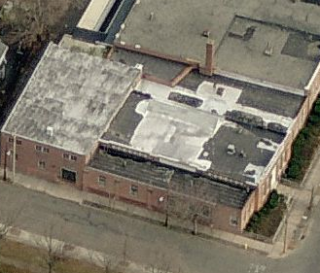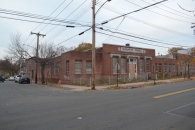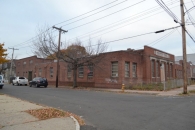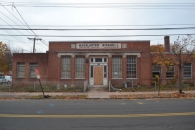Mill Record New Haven
RETURN TO ‘FIND MILLS’Disclaimer: Content for these properties was compiled in 2014-2017 from a variety of sources and is subject to change. Updates are occasionally made under Property Information, however the Connecticut Trust for Historic Preservation (dba Preservation Connecticut) makes no representation or warranty that the information is complete or up-to-date.
- Complex Name (Common)
- H. Puddicombe & Co.
- Complex Name (Historic)
-
- H. Puddicombe & Co.
- Address or Location
- 169 Henry Street, New Haven
- County
- New Haven
- Historic Designation
- Associated Mill Community
- n/a
 What can you do at this mill?
What can you do at this mill?
- Historic Information
Companies Associated w/Complex
- H. Puddicombe & Co. 1920-ca. 1945
- Macalaster Bicknell Company 1948-2012
- Rathgeber Engineering Laboratories and Rathgeber Chemical Laboratories ca. 1945-1948
Use (Historic)
- Other: Glass manufacturing
Largest Documented Workforce
Unknown.
Historic Narrative
The origins of New Haven, Connecticut’s H. Puddicombe and Company date to 1898 and the establishment of the Brown, Hubbell and Puddicombe Company. This firm specialized in the manufacture of art and leaded glass and was incorporated by Sydney L. Brown, president; Henry T. Puddicombe, secretary and treasurer; and Charles E. Hubbell, general manager. The business maintained a shop at 87 Orange Street in New Haven until 1910, when it was acquired and then operated independently by Puddicombe. In 1912, Puddicombe brought his son, Henry T. Puddicombe Jr. into the business, thus forming the firm of H. Puddicombe and Company. The business occupied the original Orange Street shop until 1920, whereupon a new factory and glazing shop was built at 181 Henry Street in New Haven. The firm continued to operate for another 15 years before it was incorporated with $50,000 in capital by Henry Puddicombe and Henry Puddicombe Jr., as well as their wives, Allie C. and Eliza M. Puddicombe, respectively, in December 1935. H. Puddicombe and Company downsized dramatically around 1945 when the firm vacated the main portion of the Henry Street plant and moved into a storage building formerly located immediately north of the factory. The main building then passed to the Rathgeber Engineering Laboratories and Rathgeber Chemical Laboratories, which since the 1930s had occupied several buildings on County Street to the northwest of H. Puddicombe and Company. The Rathgeber companies were operated by three brothers, Colin, Henry M., and J. Albert Rathgeber, and specialized in both chemical and precision engineering. The firms retained the former H. Puddicombe and Company plant for a brief period of time, having vacated the factory and returned to their former quarters at 226 County Street by 1948. The Henry Street plant next passed to the Macalaster Bicknell Company, a manufacturer of laboratory glass products. The Macalaster Bicknell Company was formed by Fred S. Macalaster and Alfred Bicknell in Cambridge, Massachusetts in 1920 and the firm established its New Haven branch on Temple Street during the early 1940s. The company moved to Henry Street in 1948 where it produced a variety of laboratory supplies including glass tubing, rods, and blanks until 2012. The Henry Street plant was closed in October 2012 after a private equity firm purchased the company and moved the business to North Haven, Connecticut. The factory was expanded and a neighboring building – formerly used as an ice cream manufactory owned by the H.P. Hood and Sons Company – was absorbed into the plant during the 1940s and 1960s, however, the entire complex remains vacant today.
- Architectural Information
Number of Existing Buildings
Six (6) adjoining primary blocks.
Dates of Construction
1920, 1930, 1937, ca. 1948, ca. 1960.
Architect
Charles E. Hubble
Builder
n/a
Building Type
Architectural Description
The former H. Puddicombe and Company plant, later expanded by the Macalaster Bicknell Company, is comprised of six primary adjoining blocks located at the northeast corner of the intersection of Henry and County Streets. The oldest portion of the complex is a one-story, 44’ x 86’ Neoclassical style red brick block located near the plant’s southwest corner. This was erected by H. Puddicombe and Company in 1920 and is easily identified by the details of its façade (south elevation). This is of a symmetrical design and consists of a central entry flanked by two large window openings on each side. These are delineated by six brick pilasters that rise to concrete caps linked by a continuous molded concrete lintel located above the five door and window openings. The windows have large, multi-pane metal sash with hopper-style openings and concrete sills. The entry consists of a single wood and glass pass-through door with a highly detailed surround. This has paneled sidelights and a tripartite transom above. Both have elaborate leaded glazing. A large concrete plaque is centered in the block’s red brick parapet and is flanked by two rectangular concrete plaques embossed with a diamond-shaped detail. The central plaque bears non-original signage which reads, ‘MACALASTER BICKNELL/LABORATORY SUPPLIES - GLASS BLOWING.’ The building has a flat roof with a single sawtooth monitor along its east elevation. The original H. Puddicombe and Company plant was enlarged by the Macalaster Bicknell Company ca. 1948 and ca. 1960. The first additions consisted of two one-story wings constructed adjoining the east and west elevations of the main block. These housed space for glass blowing and product storage and measure 16’x 46’ and 12’ x 46’, respectively. Both are of plain styling and have rectangular window openings with concrete sills and brick lintels, double-hung metal sash, concrete coping, and flat roofs. A two-story, 46’ x 78’ red brick block of similar styling was erected adjoining the plant’s north elevation ca. 1960. A one-story, 17’ x 104’ red brick block was also constructed adjoining the factory’s east elevation around the same time. This linked the Macalaster Bicknell Company factory to a neighboring plant built by the H.P. Hood and Sons Company, in 1930 and 1937. The façade of the H.P. Hood and Sons Company building bears Colonial Revival details including both rectangular and round-arched windows, the later with concrete keystones, a round-arched fanlight over the primary entrance, and six-over-six double-hung sash.
Exterior Material(s)
Structural System(s)
Roof Form
Roof Material
Power Source
Condition
Fair
Condition Notes
The complex is in fair condition. The exterior walls are in need of cleaning and minor repairs, however, most of the original windows have been retained and the facility have been generally well maintained.
- Property Information
-
Specific Location
Western portion of one legal parcel (169 Henry Street) totaling 0.72 acres located at the northeast corner of the intersection of Henry and County Streets.
Adjacent To
n/a
Exterior Visible from Public Road?
Yes
Parcel ID / Assessor Record Link
- 293/0340/00100 western building / Link →
Acreage
0.72
Use (Present)
- Other: Together with abutting former Hood factory building, opened in 2019 as NXTHVN, an arts and mentorship program by artist Titus Kaphar.
- Sources
-
Form Completed By
Lucas A. Karmazinas
Date
11/05/2015
Bibliography
- List of Connecticut Manufacturers, 1922, 1924, 1930, 1932.
- Directory of Connecticut State Manufacturers, 1936, 1939.
- Industrial Directory of Connecticut, 1947.
- Register of War Production Facilities in Connecticut, 1951.
- Map of New Haven County; Clark, Richard, 1859.
- Atlas of New Haven County, Beers, Ellis & Soule, 1868.
- Aerial Survey of Connecticut, 1934, 1965.
- Sanborn Map Company, 1901, 1911, 1923, 1950.
- New Haven City Directory; Various editions.
- Hartford Courant, 1935, 1942.
- History of the City of New Haven to the Present Time, 1887.
- A Modern History of New Haven and Eastern New Haven County, 1920.
- Representative View(s)Click on image to view full file







